Panmen, remembering the history of Wu and Yue at the gate of water and land (Part 1)
★ Tourist location: Suzhou Panmen Scenic Area
Suzhou has always been famous for its gardens. Humble Administrator's Garden and Lingering Garden are all famous for their exquisiteness, attracting a large number of Chinese and foreign tourists. Panmen, on the other hand, has been neglected for a long time.

In fact, I had been to Panmen many years ago and was fascinated by this ancient building from the Yuan Dynasty. Later, I wanted to visit again many times, but I always wasted it because of various excuses. I finally picked a fine day, put on my simple bags, and embarked on a trip to Panmen.

The bus I took soon arrived at the station. When I saw the city wall in front of me, I was quite confused. Has this city gate been renovated so new? Although the city wall is built very simple and dignified, its quality is not 100% new, but 95% old, right? Doesn't it seem a little far from the city gate in my memory? Is this really a pandoor? I suddenly doubted the memory I was once proud of.

As I got closer, I finally realized that this was not a pan-gate, but a Pan Pacific Hotel. The entrance was built under the city wall and there was a slope on the side for driving cars to the "city wall". The door is stylish and unique. If it weren't for the price, we would have checked in tonight!
After walking not far along the navigation, we reached the real Panmen Scenic Area. The tall and magnificent boat seems to have been newly built in recent years, showing us that we have long longed for Panmen. This is the east gate of the scenic area.

Ruiguang Tower is the tallest building in Panmen. Back then, this tower did not require additional small tickets, but now there is a ticketing point in front of the tower, and additional tickets are charged to climb the tower. Suzhou people are really too smart...
On the south side of the Ruiguang Tower is the Ruiguang Tower Monument. It turns out that this tower was made by Emperor Taizu, and its specifications are absolutely superior. On the north side is the auxiliary white ox, which is entirely white.

Walking into Siruitang is a wooden screen, and the front is a woodcut landscape map of a pan door. It is similar to today's hand-drawn maps, but more exquisite. On the back are some text instructions. Although I don't know who wrote it in calligraphy, it seems that the person who wrote it was not an unknown person.

On both sides are the Bell Tower and Drum Tower, connected by a corridor. Although it is not open, you can still see the clocks and drums inside through the glass window.
There is a Yuanzhao Buddhist lecture seat on the back. It is a monk sitting cross-legged, holding a Buddha bead in one hand and laying it flat in the other. He is probably still reading Buddhist scriptures in his mouth. The head has been touched until it has lost its white color. It can be imagined that there should be many tourists in Panmen.
Standing here and looking at the attic in the middle of the lake, with willow branches and Buddhist embankments on both sides. Although the willow leaves have not yet grown, the posture of the willow trees itself is extremely beautiful. Although there is not a mountain color here, there is 90% lake light.

There is also a rectangular stone pool next to the drum tower, and in the center is "white turtles listen to Zen". Connecting the statue that taught scriptures, there may be a story in it such as "white turtles also listen to scriptures", which of course proves that this master Yuanzhao's scriptures are well taught. It is said that in the third year of Yuanfeng of the Northern Song Dynasty, the eminent monk Yuan Zhao opened an altar in Ruiguang Zen Temple to teach scriptures. Four auspicious signs appeared: the pagoda released auspicious light, the drum sounded by itself, the white turtle listened to Zen, and the bamboo exploded with green. This gave rise to the name of Sirui Hall.
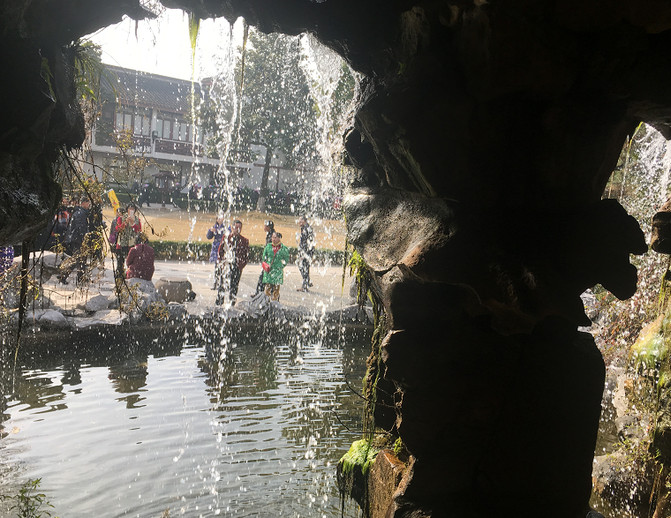
Although I can also walk along the lake here, I looked at the signs and decided to go to Panmen first. After all, this scenic spot was built because of Panmen. Who is Panmen in the central and key scenic spot?
Return to the Bell Tower and walk through the Chunshui Bridge to Ziyun Garden and Sufei Garden. Walking inside, the scenery was very ordinary, so I returned to the lake.

"Yisheng" is a corridor with an antique style and a pair of couplets that stretch along the lake and are about a hundred meters long.
The sun is shining today, the winter wind is very light, and the water is calm. The lake is not very regular. Occasionally, a piece will shrink in and occasionally a piece will protrude out. Several evergreen shrubs or trees are planted on the lawn by the lake, trimmed into the shape of a bonsai.

There is a rockery on the side. Although it is not large, a pavilion has also been built on top of the rockery. Climb up and take a look. After all, the height is limited, so I can't see the scenery of Panmen.
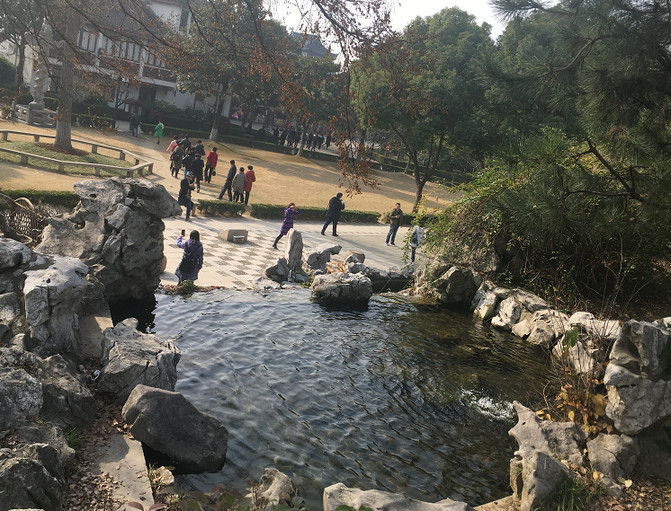
When you go down the mountain and enter the cave, you can hear the gurgling sound of water. This is clearly a small curtain cave, right? At the entrance of the cave, you can see the spring water falling in dots and lines, as if hanging a crystal curtain on the entrance of the cave.

Panmen is located on the southwest corner of the scenic area. The existing structure is a relic of the Yuan Dynasty. It consists of two water and land gates, a wengcheng, a tower and city walls on both sides. It is the only well-preserved water and land parallel gate in China and even in the world.
Shuicheng Gate is connected to the Grand Canal outside the city, and there is a cruise ship terminal on the side. Tourists can take cruise ships directly into Shuicheng Gate and Shuicheng City and ashore.

The water gate is formed by two arched gates and a water barrel city. The sluice can be opened and closed at any time with a hinged gate. This design is mainly for war preparation and can also prevent floods. It is a pioneering work based on local conditions in the ancient history of city building. This kind of gate is probably unimaginable in the north, but it is still very practical in the water town of Jiangnan.

The water gate consists of two internal and external gates, 4.6 meters apart and 24.5 meters deep. The inner door consists of three parallel stone arches. The three arches are of different sizes. The third arch is the largest, 9.7 meters high, 9.3 meters wide and 4 meters deep. The architectural structures of the inner and outer water gates are different, so historians believe that they are not relics of the same era. According to textual research, the outer gate is obviously earlier than the inner gate.

According to ancient records, Suzhou City was originally built by Wu Zixu, King Helu of Wu, in the sixth year of King Jing of Zhou, to be built as the capital of Wu in the Spring and Autumn Period. Panmen was called Panmen in ancient times because there was once a Panlong on the gate. Panmen is one of the eight gates of Wu Gate, which is consistent with the orientation drawn by the monument in the "Pingjiang Tu" of the Southern Song Dynasty. The overall layout and architectural structure basically maintain the old view of the late Yuan and early Ming Dynasty.

The wall of Panmen is 300 meters long and more than five meters high. The top of the wall is a wide platform, from which you can see the entire layout and structure of the Lu Men, Shuimen, and Weng City.

The city wall also retains serrated crenades, female walls, perforations, gate gridlock stones, and fire hole gridlock stones. They are one of the ancient offensive and defensive fortifications facilities. Most of them are located on the city gates and passes, and their main function is to defend against the enemy. Panmen, water and water gates are juxtaposed, and both have twist gate stones, especially the twist gate stones of the water gate, which can not only resist the enemy but also control the water level. It can be said to be used to kill two birds with one stone.

There are three earthen cannons directly in front of and southeast of the tower. Of course, they are not equipment from the Wu Dynasty. The red-clad cannons only appeared on the historical stage in the late Ming Dynasty. These earthen cannons were produced in the Qing Dynasty. The gun bodies are 120 cm, 130 cm, and 160 cm respectively, and the muzzle diameters are 8 cm, 10 cm, and 12 cm respectively.

The Wengcheng is a square with a side length of about 20 meters. It is located between two land gates. The belly is large and the surrounding walls are steep. Once the enemy is lured deep, the gate will cut off the retreat, just like catching turtles in a barrel, and the enemy can be completely wiped out. The current Wengcheng was rebuilt by Zhang Shicheng at the end of the Yuan Dynasty. Later, after being built in the Ming and Qing Dynasties, the original shape can still be seen.

The General Tower was built in 514 BC. It was called "Dianjiangtai" in ancient times. It was built when Wu Zixu built Helu City. It was built on the water and land gate, Wengcheng and the city walls on both sides, Fu Chai, King of Wu, and Wu Zixu, the prime minister, sent troops here to point out. Although it has endured many wars and man-made damage, and has been restored several times, it is the only well-preserved General Building in Suzhou City.
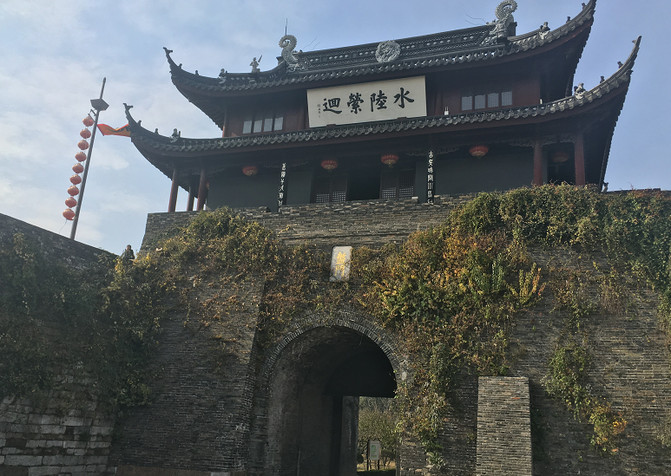
Standing in front of the building, you can see that the house is like a tree. Among the dense green trees, there are black tiles and faintly exposed white walls. Occasionally, there is a yellow wall, which makes it a little eye-catching. Farther away are the high-rise buildings in Suzhou.

There are more deciduous trees planted on the other side, exposing complete houses, which is also the scope of Panmen Scenic Area. It seems that these houses are still very new, probably built around the scenic spot.
Outside the city is the simple and dignified Wumen Bridge. This is the tallest existing ancient stone arch bridge in Suzhou. It was built in the seventh year of Yuanfeng in the Northern Song Dynasty and rebuilt into a single-hole stone arch bridge in the Qing Dynasty.
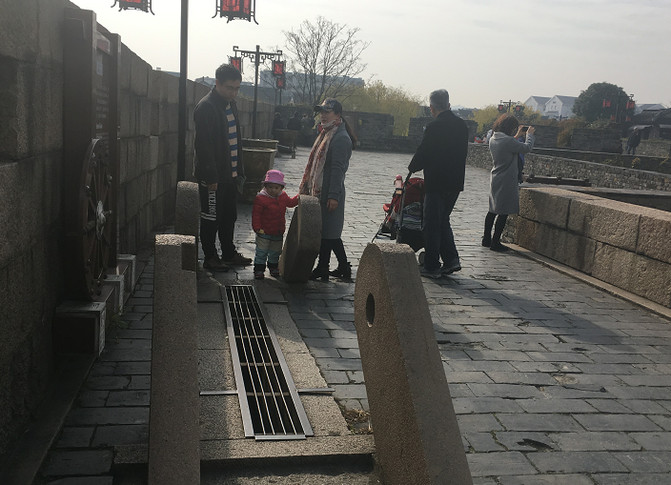
A big flag with the character "Wu" fluttered in the wind, reminding people of the ancient history of this gate. When Wu was established as the capital, King Helu of Wu became the overlord of the Spring and Autumn Period with the assistance of Wu Zixu, and Suzhou also became a famous historical city.

The inner circumference is about 177 meters, and the city wall is 8.1 meters high. The bottom is based on strips of stone, the top is built with city bricks, and the inner and outer doors are hidden. The outer door is in the northeast direction and consists of three longitudinally connected, segmented and parallel stone arches. The left and right city walls are made of granite and should have been rebuilt in modern times. The inner door is located to the southwest and consists of three brick arches. The second arch is laid at a 90-degree transformation. The first and third arches are each three layers thick, using a masonry method of two studs and one smooth. A trapezoidal protective wall is built on the left and right sides of the door, and a small window in the shape of a "pin" is opened on the first arch, which is a water outlet for dealing with enemy fire attacks.

Exit Panmen is Wumen Bridge, which is also one of the exits of the scenic area. Having not finished touring the scenic spot, I was naturally unwilling to go out like this, so I glanced at Wumen Bridge at the door and continued to return to the scenic spot.


Poetry to remember:
Ruiguang Tower is far away from Penglai,
The ancient charm of water and land lingers.
At the head of Lijing Tower, the sea is exhausted, leaving only the remnant wine for the heroic soul.







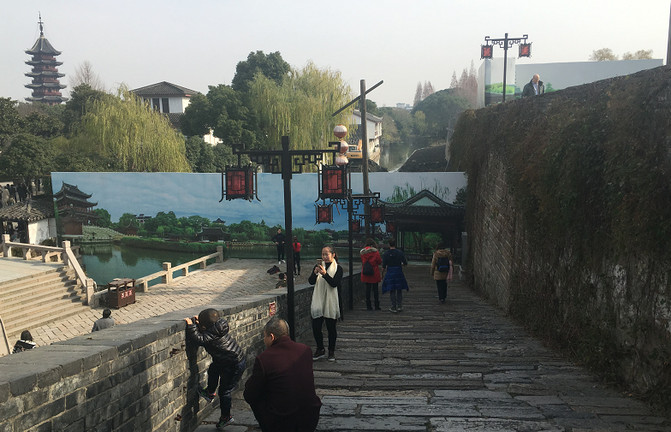



Previous Article:Take a look at Luzhi-Baosheng Temple, Ye Shengtao Memorial Hall
Next Article:Autumn wind rises, crab feet are itchy, and Indigo walks on Yangcheng Peninsula in Suzhou ~
